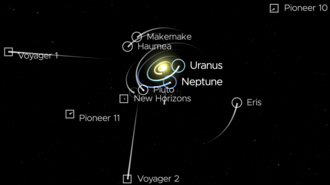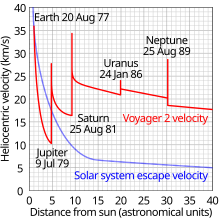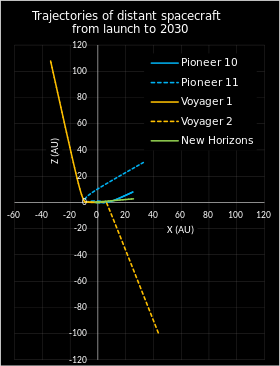
Back قائمة الأجسام الاصطناعية خارج النظام الشمسي Arabic Llista d'objectes artificials que surten del sistema solar Catalan Anexo:Objetos artificiales más lejanos Spanish Aurinkokunnan ulkopuolella olevat luotaimet Finnish Popis umjetnih predmeta koji napuštaju Sunčev sustav Croatian 太陽系を離れる人工物の一覧 Japanese Lista de objetos artificiais deixando o Sistema Solar Portuguese Lista obiectelor artificiale care au părăsit sistemul solar Romanian Список штучних космічних об'єктів, які покинули межі Сонячної системи Ukrainian 離開太陽系的人造物體列表 Chinese


Several space probes and the upper stages of their launch vehicles are leaving the Solar System, all of which were launched by NASA. Three of the probes, Voyager 1, Voyager 2, and New Horizons are still functioning and are regularly contacted by radio communication, while Pioneer 10 and Pioneer 11 are now defunct. In addition to these spacecraft, some upper stages and de-spin weights are leaving the Solar System, assuming they continue on their trajectories.
These objects are leaving the Solar System because their velocity and direction are taking them away from the Sun, and at their distance from the Sun, its gravitational pull is not sufficient to pull these objects back or into orbit. They are not impervious to the gravitational pull of the Sun and are being slowed, but are still traveling in excess of escape velocity to leave the Solar System and coast into interstellar space.
© MMXXIII Rich X Search. We shall prevail. All rights reserved. Rich X Search

